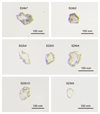Evidence for extremely rapid magma ocean crystallization and crust formation on Mars
- PMID: 29950620
- PMCID: PMC6107064
- DOI: 10.1038/s41586-018-0222-z
Evidence for extremely rapid magma ocean crystallization and crust formation on Mars
Abstract
The formation of a primordial crust is a critical step in the evolution of terrestrial planets but the timing of this process is poorly understood. The mineral zircon is a powerful tool for constraining crust formation because it can be accurately dated with the uranium-to-lead (U-Pb) isotopic decay system and is resistant to subsequent alteration. Moreover, given the high concentration of hafnium in zircon, the lutetium-to-hafnium (176Lu-176Hf) isotopic decay system can be used to determine the nature and formation timescale of its source reservoir1-3. Ancient igneous zircons with crystallization ages of around 4,430 million years (Myr) have been reported in Martian meteorites that are believed to represent regolith breccias from the southern highlands of Mars4,5. These zircons are present in evolved lithologies interpreted to reflect re-melted primary Martian crust 4 , thereby potentially providing insight into early crustal evolution on Mars. Here, we report concomitant high-precision U-Pb ages and Hf-isotope compositions of ancient zircons from the NWA 7034 Martian regolith breccia. Seven zircons with mostly concordant U-Pb ages define 207Pb/206Pb dates ranging from 4,476.3 ± 0.9 Myr ago to 4,429.7 ± 1.0 Myr ago, including the oldest directly dated material from Mars. All zircons record unradiogenic initial Hf-isotope compositions inherited from an enriched, andesitic-like crust extracted from a primitive mantle no later than 4,547 Myr ago. Thus, a primordial crust existed on Mars by this time and survived for around 100 Myr before it was reworked, possibly by impacts4,5, to produce magmas from which the zircons crystallized. Given that formation of a stable primordial crust is the end product of planetary differentiation, our data require that the accretion, core formation and magma ocean crystallization on Mars were completed less than 20 Myr after the formation of the Solar System. These timescales support models that suggest extremely rapid magma ocean crystallization leading to a gravitationally unstable stratified mantle, which subsequently overturns, resulting in decompression melting of rising cumulates and production of a primordial basaltic to andesitic crust6,7.
Conflict of interest statement
The author declares no competing financial interests.
Figures



Comment in
-
Mars beat Earth in the race for habitable conditions.Nature. 2018 Jun;558(7711):522-523. doi: 10.1038/d41586-018-05496-0. Nature. 2018. PMID: 29946096 No abstract available.
References
-
- Stevenson RK, Patchett PJ. Implications for the evolution of continental-crust from Hf-isotope systematics of Archean detrital zircons. Geochim Cosmochim Acta. 1990;54:1683–1697.
-
- Amelin Y, Lee D-C, Halliday AN, Pidgeon RT. Nature of the Earth's earliest crust from hafnium isotopes in single detrital zircons. Nature. 1999;399:252–255.
-
- Amelin Y, Lee D-C, Halliday AN. Early-middle Archaean crustal evolution deduced from Lu-Hf and U-Pb isotopic studies of single grain zircons. Geochim Cosmochim Acta. 2000;64:4205–4225.
-
- Humayun M, et al. Origin and age of the earliest Martian crust from meteorite NWA 7533. Nature. 2013;503:513–516. - PubMed
-
- McCubbin FM, et al. Geologic history of Martian regolith breccia Northwest Africa 7034: Evidence for hydrothermal activity and lithologic diversity in the Martian crust. Journal of Geophysical Research: Planets. 2016;121:2120–2149.
Publication types
Grants and funding
LinkOut - more resources
Full Text Sources
Other Literature Sources
Research Materials
Miscellaneous

